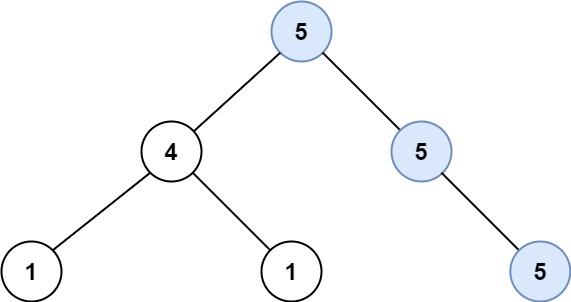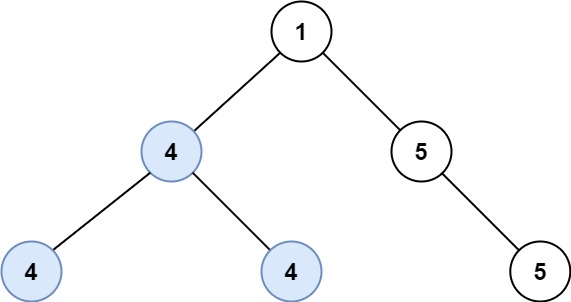LC 687. 最长同值路径
题目描述
这是 LeetCode 上的 687. 最长同值路径 ,难度为 中等。
给定一个二叉树的 root,返回 最长的路径的长度 ,这个路径中的 每个节点具有相同值 。 这条路径可以经过也可以不经过根节点。
两个节点之间的路径长度 由它们之间的边数表示。
示例 1:
1
2
3输入:root = [5,4,5,1,1,5]
输出:2
示例 2:
1
2
3输入:root = [1,4,5,4,4,5]
输出:2
提示:
- 树的节点数的范围是 $[0, 10^4] $
- $-1000 <= Node.val <= 1000$
- 树的深度将不超过
1000
递归
设计递归函数 int dfs(TreeNode root),含义为传入根节点 root,返回以该节点为起点,往下走同值路径所能经过的最大路径长度(即不能同时往左右节点走),同时使用全局变量 max 记录答案路径所能经过最大路径长度。
在递归函数内部,先通过递归 root 的左右子节点,拿到以 root.left 和 root.right 为起点的最大路径长度 l 和 r,然后根据当前节点值和左右子节点值的相等关系来更新 ans,同时用 cur 维护「以当前节点 root 为目标路径中深度最小(位置最高)节点时」所经过的最大路径长度。
Java 代码:1
2
3
4
5
6
7
8
9
10
11
12
13
14
15
16
17
18
19class Solution {
int max = 0;
public int longestUnivaluePath(TreeNode root) {
dfs(root);
return max;
}
int dfs(TreeNode root) {
if (root == null) return 0;
int ans = 0, cur = 0, l = dfs(root.left), r = dfs(root.right);
if (root.left != null && root.left.val == root.val) {
ans = l + 1; cur += l + 1;
}
if (root.right != null && root.right.val == root.val) {
ans = Math.max(ans, r + 1); cur += r + 1;
}
max = Math.max(max, cur);
return ans;
}
}
C++ 代码:1
2
3
4
5
6
7
8
9
10
11
12
13
14
15
16
17
18
19
20
21class Solution {
public:
int maxv = 0;
int dfs(TreeNode* root) {
if (root == nullptr) return 0;
int ans = 0, cur = 0;
int l = dfs(root->left), r = dfs(root->right);
if (root->left != nullptr && root->left->val == root->val) {
ans = l + 1; cur += l + 1;
}
if (root->right != nullptr && root->right->val == root->val) {
ans = max(ans, r + 1); cur += r + 1;
}
maxv = max(maxv, cur);
return ans;
}
int longestUnivaluePath(TreeNode* root) {
dfs(root);
return maxv;
}
};
Python 代码:1
2
3
4
5
6
7
8
9
10
11
12
13
14
15
16
17
18class Solution:
def longestUnivaluePath(self, root: Optional[TreeNode]) -> int:
maxv = 0
def dfs(root):
nonlocal maxv
if not root: return 0
ans, cur = 0, 0
l, r = dfs(root.left), dfs(root.right)
if root.left and root.left.val == root.val:
ans = l + 1
cur += l + 1
if root.right and root.right.val == root.val:
ans = max(ans, r + 1)
cur += r + 1
maxv = max(maxv, cur)
return ans
dfs(root)
return maxv
TypeScript 代码:1
2
3
4
5
6
7
8
9
10
11
12
13
14
15
16
17
18let max = 0;
function longestUnivaluePath(root: TreeNode | null): number {
max = 0
dfs(root)
return max
};
function dfs(root: TreeNode | null): number {
if (root == null) return 0
let ans = 0, cur = 0, l = dfs(root.left), r = dfs(root.right)
if (root.left != null && root.left.val == root.val) {
ans = l + 1; cur += l + 1
}
if (root.right != null && root.right.val == root.val) {
ans = Math.max(ans, r + 1); cur += r + 1
}
max = Math.max(max, cur)
return ans
}
- 时间复杂度:$O(n)$
- 空间复杂度:忽略递归带来的额外空间开销,复杂度为 $O(1)$
最后
这是我们「刷穿 LeetCode」系列文章的第 No.687 篇,系列开始于 2021/01/01,截止于起始日 LeetCode 上共有 1916 道题目,部分是有锁题,我们将先把所有不带锁的题目刷完。
在这个系列文章里面,除了讲解解题思路以外,还会尽可能给出最为简洁的代码。如果涉及通解还会相应的代码模板。
为了方便各位同学能够电脑上进行调试和提交代码,我建立了相关的仓库:https://github.com/SharingSource/LogicStack-LeetCode 。
在仓库地址里,你可以看到系列文章的题解链接、系列文章的相应代码、LeetCode 原题链接和其他优选题解。
本博客所有文章除特别声明外,均采用 CC BY-SA 4.0 协议 ,转载请注明出处!
